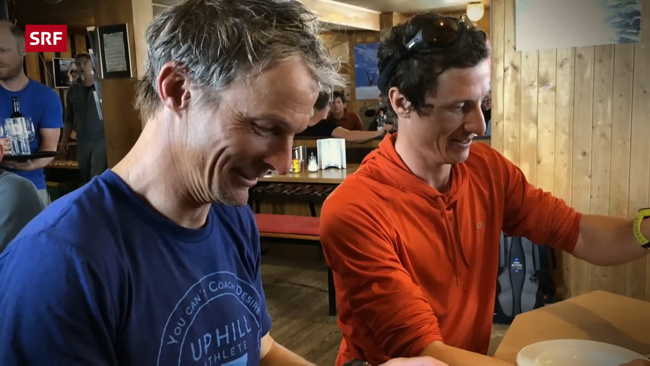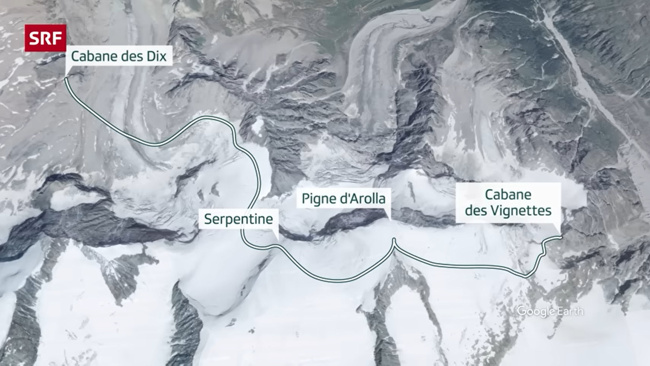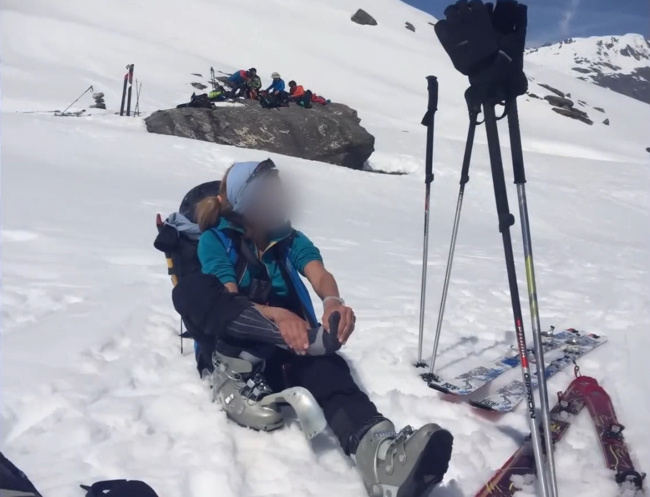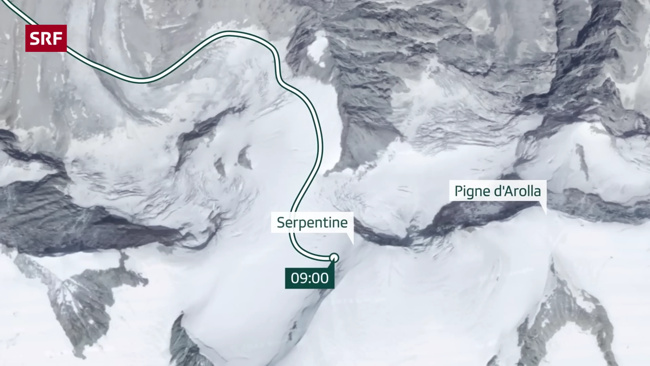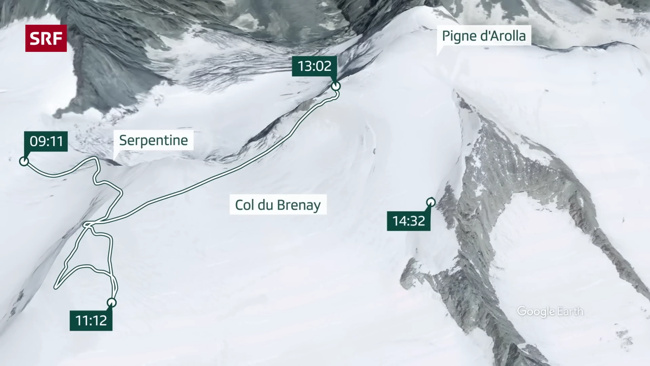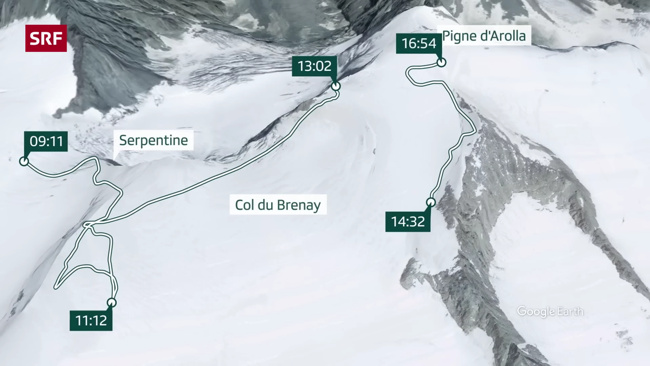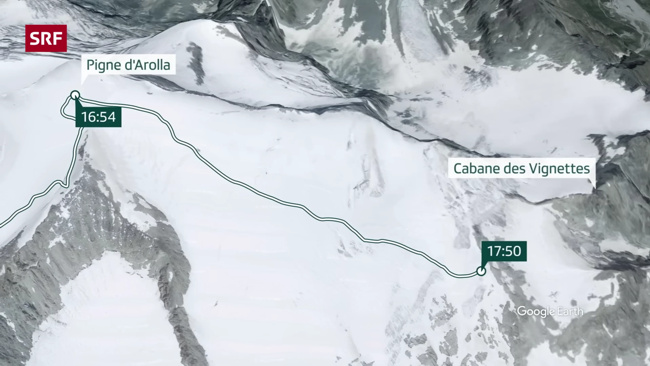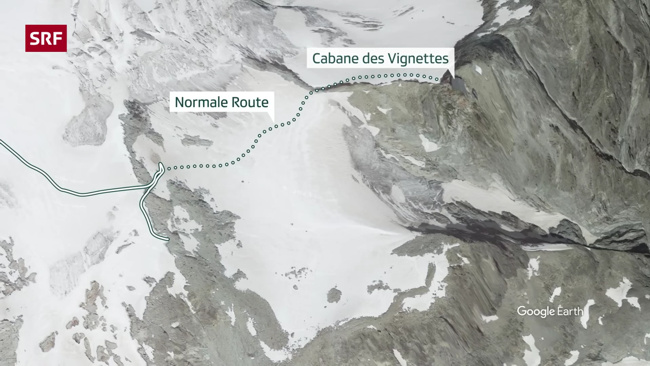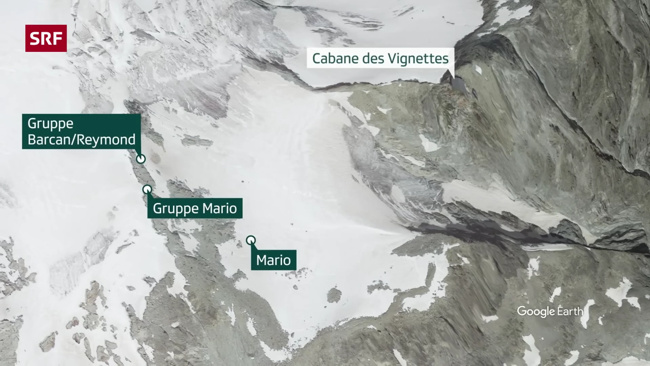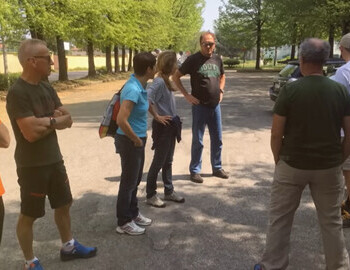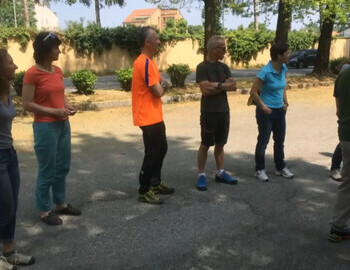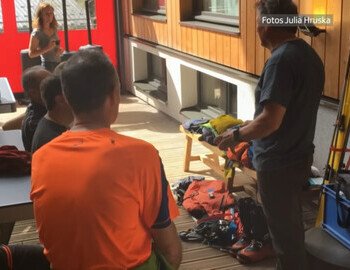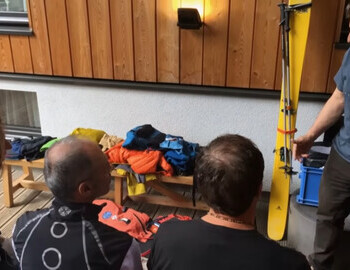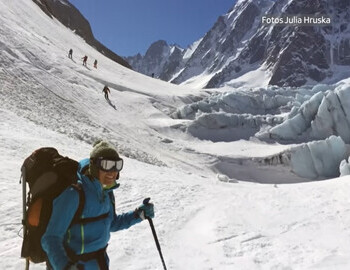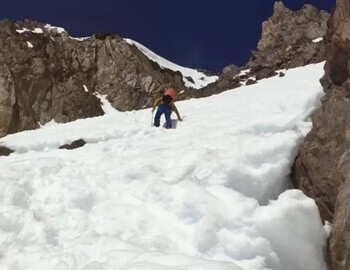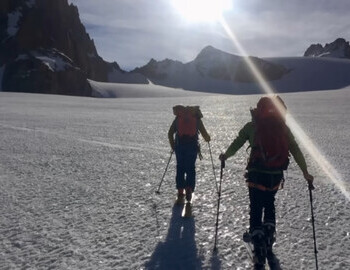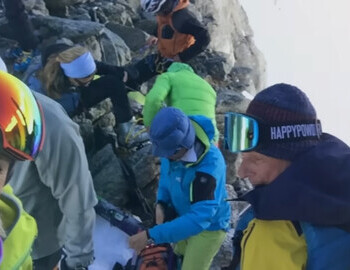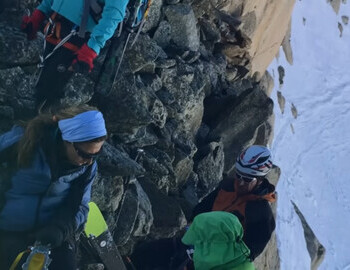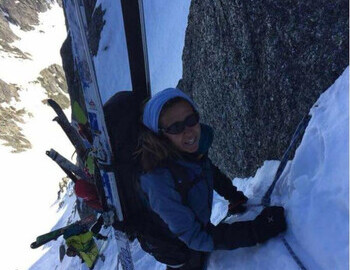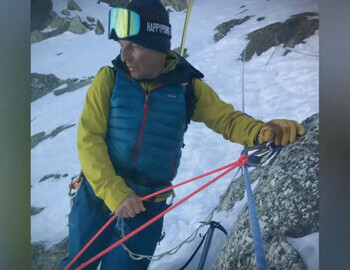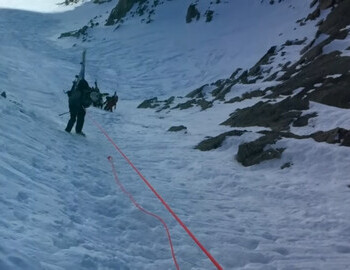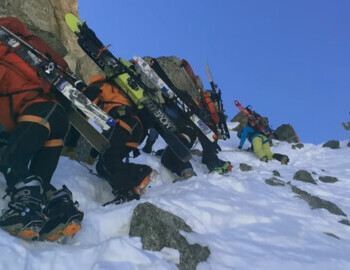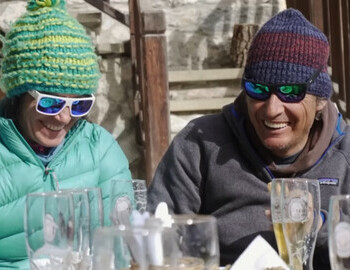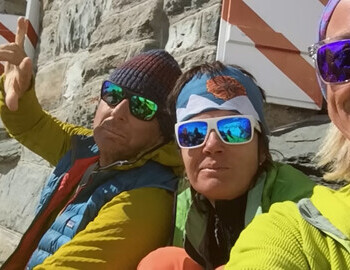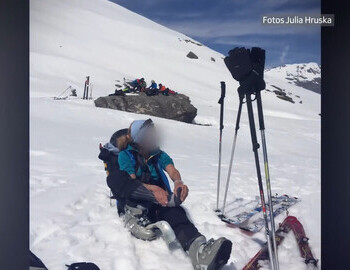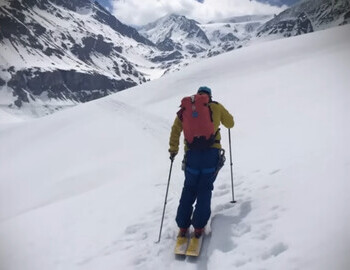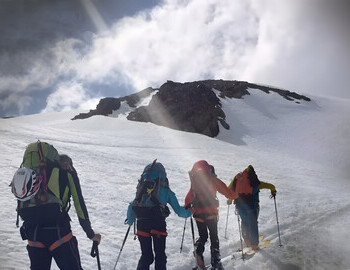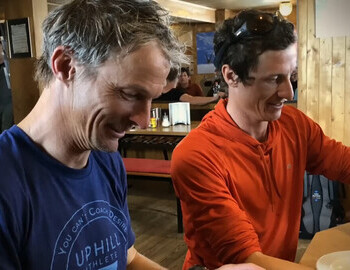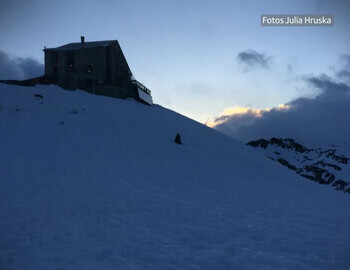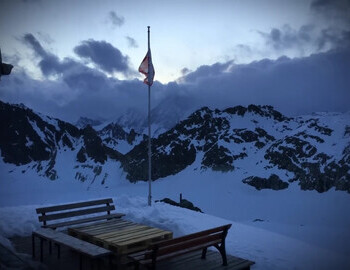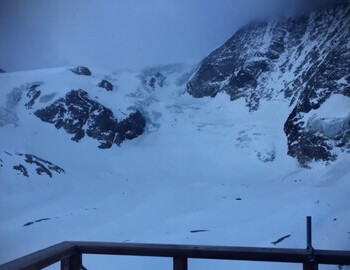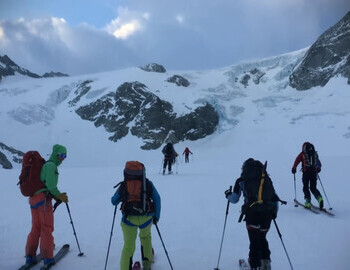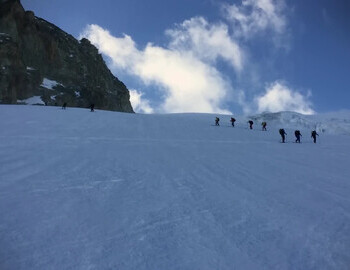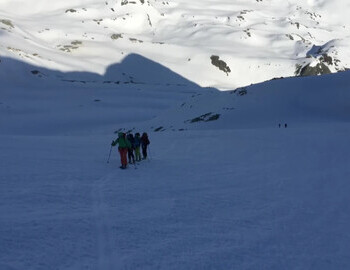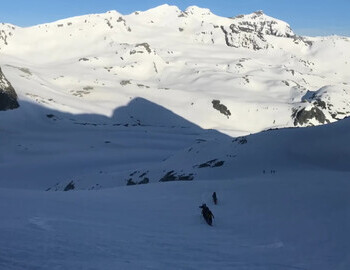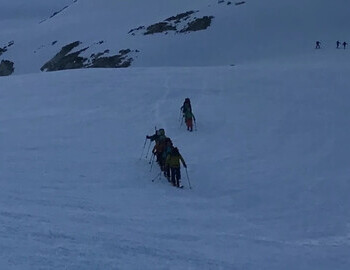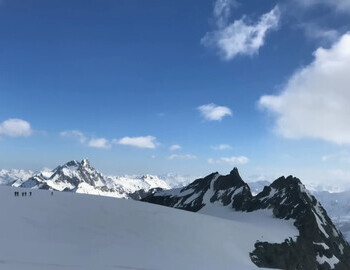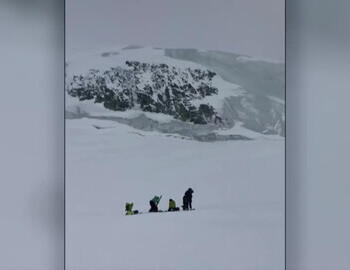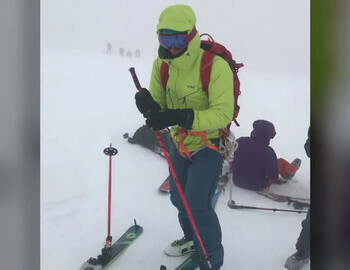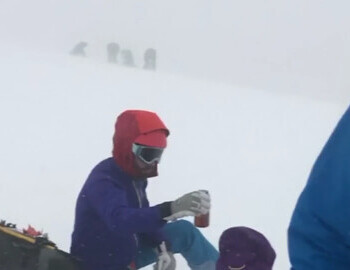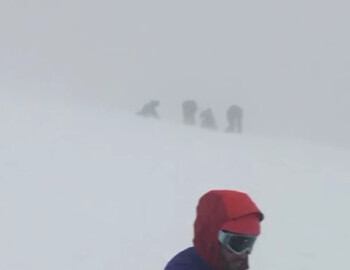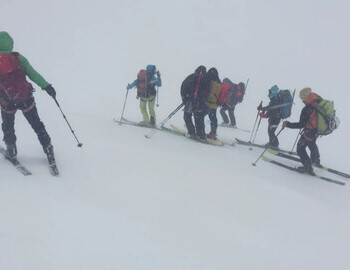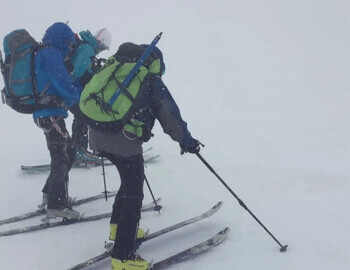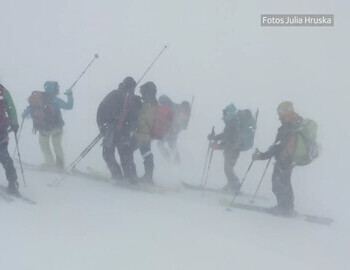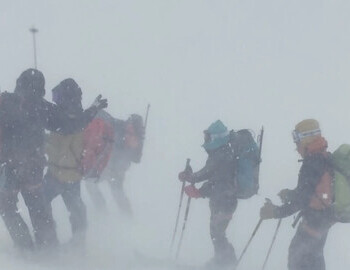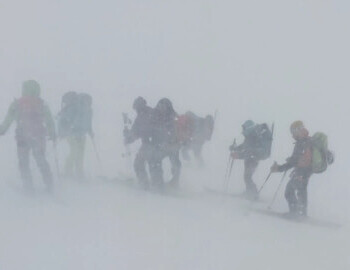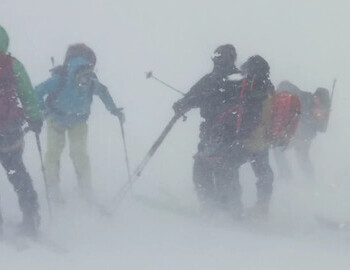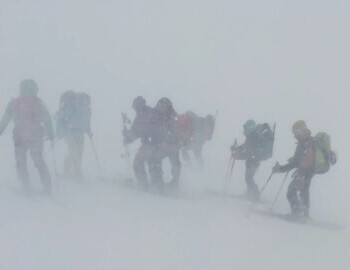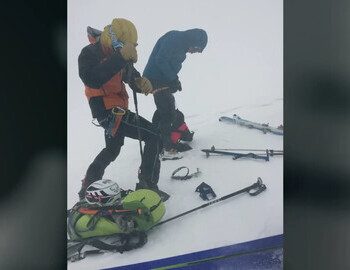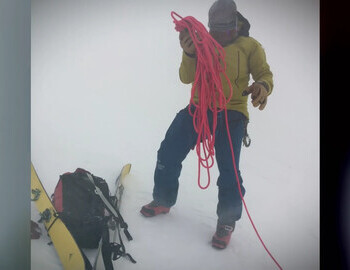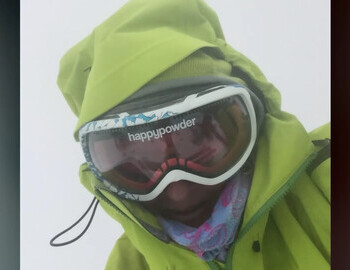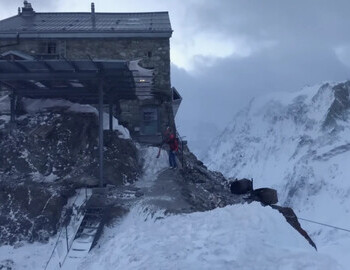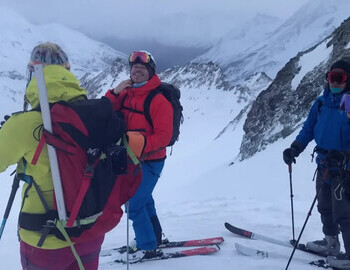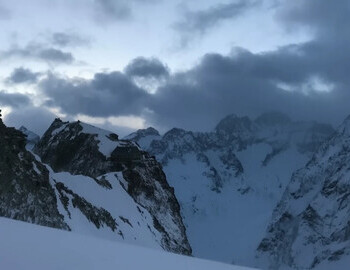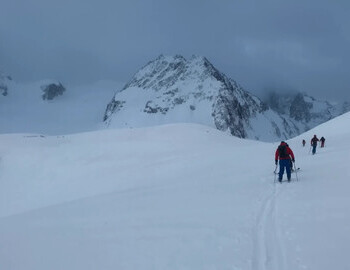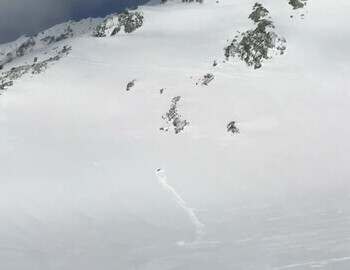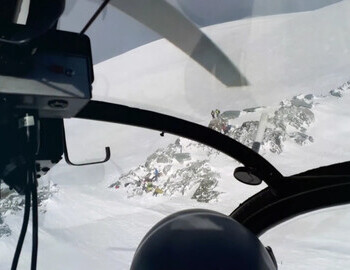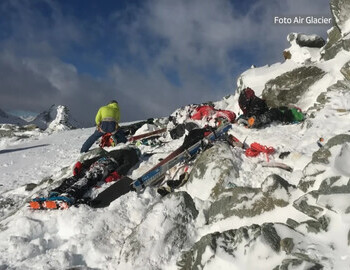
Death in the Alps
Foreword
Why talk now, why at all? It happened in 2018 and seems like a very common multiple deaths incident in the Swiss Alps due to bad weather and poor decisions. No mystery there.
The answer is underlined below. I knew the second guide if you can call her that, she was a licensed guide all right, but everybody saw her as the wife of the seasoned guide. From the very beginning it was sad topic, almost one that you want to forget because there was nothing to learn form it. Horrific misjudgement of circumstances. It is to this day. So what changed? I am addicted to true crime and incidents in the mountain. The only topic I am annoyed by is Dyatlov Pass. I can not make people fact check there, but when I stumbled upon a YouTube video where the guide's wife name was different, and the photo was of a different person, I took it upon myself to correct the author. I wanted to point to a source with the correct information. And I saw a 2023 documentary in German which filled me in with the details that made this disaster worthy of a second look. The new element was the point of view of the survivors that speak in this documentary. The plateau after Pigne d'Arolla became a putry dish for disaster. I knew that there was a second group that only just survived the night, but I didn't know there was a third group that got to the hut and was celebrating the day unaware that the rest of the groups they started their trek with in the morning were slowly dying 550 m from the hut unable to call for help. And the three groups were moving together up to the point when the mountain seeped fog on to the petry dish. That separated the groups. And then came the storm. Questions in my mind started jumping like a popcorn in a microwave.
The saying "all happy families are alike; each unhappy family is unhappy in its own way" is the famous opening line from Leo Tolstoy's novel, Anna Karenina. This concept is sometimes called the Anna Karenina Principle.
This principle can be applied to other areas, such as mountain treks, to explain why success is often dependent on meeting multiple criteria, while failure can result from a single deficiency.
Replace in the following sentences the word "family" with "hiking group", "health" with "weather", "financial security" with "terrain", and "mutual affection" with "people".
Happy families hiking group: According to Tolstoy, happiness requires the right balance of several fundamental elements, such as health weather, financial security terrain, and mutual affection people. Because all these requirements must be met simultaneously, happy families hiking groups have a similar, shared foundation.
Unhappy families hiking group: Conversely, a family hiking group can become unhappy for any number of reasons. A failure in just one of the key aspects is enough to create a dysfunctional family hiking group, and each family's hiking group's specific failure point makes their unhappiness unique.
You would ask - why don't you just give us the link to the documentary and stop with the references. Because the documentary has the right to only tell what the participants in the film say, and it is treating the basics as if you already know all this. I had this same problem when I started working on the very site you are reading this on, Dyatlovpass.com. I couldn't make head nor tail of it. Bellow are the key elements from this documentary not in the order given it in the film but in advance so you know what happen. Then when you see the documentary you will understand, at least I did, how it happened. After that you will come to the point where I stand now, pondering on the question why did it happen.
Most people, including the survivors, go straight to "Shouldn't have gone that day, or should have turned around..." which is obviously the way to not die that night. The questions I have is "What made the third group so different that they did not have problems?" Or should they also not have attempted the trek that day? The doomed group had GPS track, satellite phone and the hikers were experienced. All three points failed. The phone with the GPS track froze (remained unresponsive). BTW I had exactly the same happening to me on the Dyatlov Pass this year. The satellite phone had juice but just didn't work. And the guide lost his ski mask in the 150km/h wind so he was basically blind. What is to say that this couldn't happen to the third group?
Anyways, after seeing this documentary the one time clear and sad case of the death of my countrywoman raised new questions. It is almost like besides the common sense you also need a little bit of luck. The Mountain is where even the nonbelievers pray to God.
- 2 -
Just the facts, ma'am
The tragedy took place on Day 4 of the Haute Route, or High Route, from Chamonix in France to Zermatt in Switzerland. A week on skis and crampons. Up to this point all has been great. On this particular day the group had to go from Cabane de Dix to Cabane de Vignettes. Distance: 10.3 km (6.4 miles); Average time: 5.5 to 6 hours; Difficulty: Challenging; Elevation gain: 3,713 feet (1,132 meters)
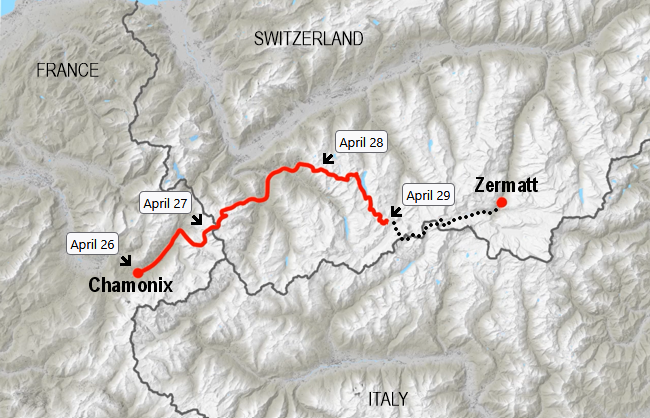
Click to open an interactive map in a separate window. Source DER SPIEGEL
There were seven or eight groups spent the night in Cabane de Dix, but only started off to Cabane de Vignettes in the morning. These groups were:
The "Italians"
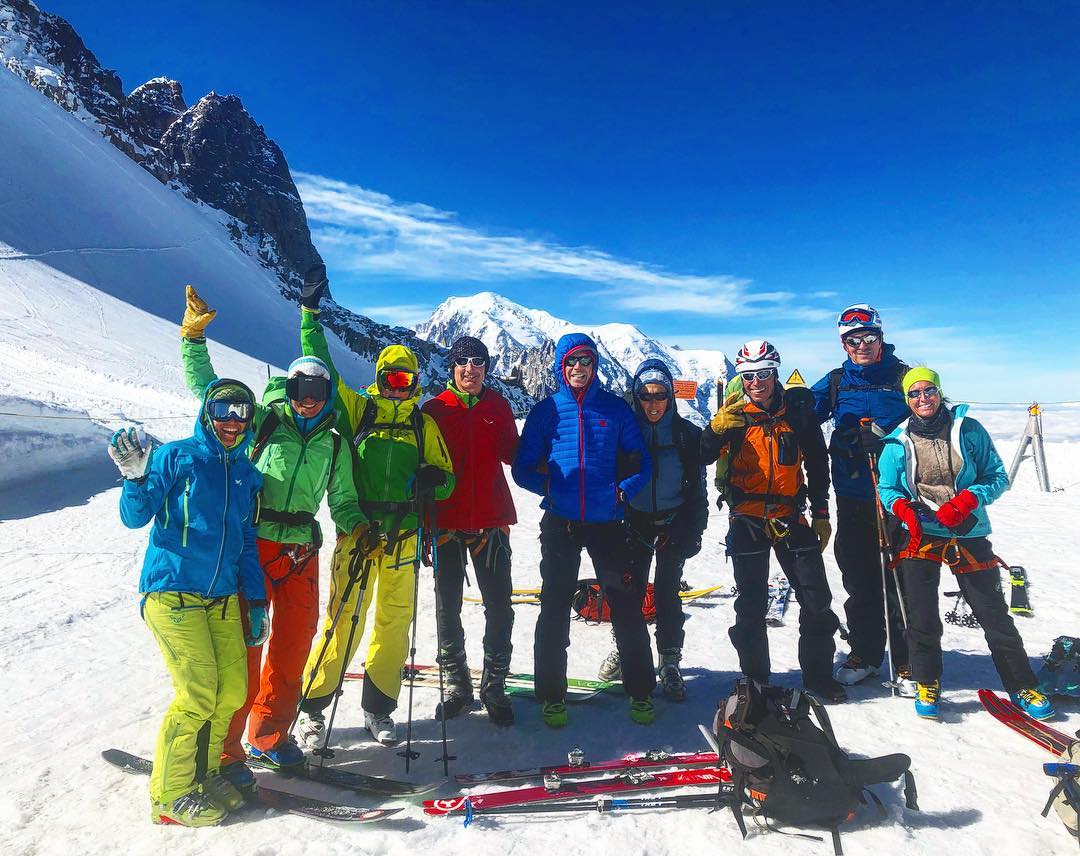
Julia, Kalina, Francesca, Andrea, Marcello, Gabriella, Luciano, Tommaso, and Betty, photo taken by Mario on April 26, 2018
R.I.P.
Survivors
* age at the time of the tragedy
Mario Castiglioni (59) Italy
internationally certified mountain guide, Mario had lived in Chamonix for a long time and knew the Alps and the Haute Route. For him, the Haute Route in spring often marked the end of a long winter season. This time was no different. He was a person who, with his experience, radiated calm. But he always kept a little apart from the group. Mario was a man of a few words. He was primarily interested in making sure everything worked. Mario was physically very strong and calm in moments of stress.
Kalina Damyanova (52) Bulgaria
Bulgarian mountain guide, spoke 5 languages, married to Mario Castiglioni in 2011. Тogether they ran the company MLG Mountain Guide in Chiasso, Switzerland.
Mario and Kalina were well-coordinated team. There was little discussion about who did what. Kalina is a certified hiking and tour guide and ski instructor, trained in Bulgaria. With a lot of experience in the high mountains and on high-altitude tours, but she's not a mountain guide*. Kalina was very good and more approachable than Mario. She was really nice and warm. That was the main difference. Kalina and Mario met ten years ago in Bulgaria and soon afterward were traveling together as a couple on mountains all over the world before they married.
*A mountain guide specializes in leading expeditions in mountains, focusing on safety, technical skills, and managing risks during activities like climbing, skiing, and hiking. A tour guide leads groups through cities, museums, or historical sites, focusing on providing information about history, culture, and local attractions. The primary distinction is the environment and the critical nature of safety versus information dissemination in each role.
Julia Hruska (47*) Italy
nurse
Luciano Cattori (72*) Italy
despite his age he is in excellent shape. About 45 or even 50 years ago, he skied the Haute Route with the equipment of the time, heavy skis and very hard boots. Now he wanted to repeat the route with modern equipment.
Francesca Von Felten (42) Italy
homemaker, mother of three, an experienced ski mountaineer and climber. She had climbed the Aconcagua, the highest mountain in South America, the year before.
Tommaso Piccioli (50*) Italy
a 50-year-old architect from Milan who has been going ski touring since 1990 and has been a member of the Alpine Club for more than 20 years. Over the years, he had organized numerous ski tours, canoeing, mountain bike expeditions and hikes for himself and his friends in Europe and Australia. He was accompanied by three friends, members of the Bolzano Alpine Club Section, where he had attended some courses in recent years.
Elisabetta (Betty) Paolucci (44) Italy
school teacher
Marcello Alberti (53) Italy
tax adviser
Gabriella Bernardi (52) Italy
human resources
Andrea Grigioni (45) Italy
male nurse from Como, Italy, who had taken the place of another Italian who had to cancel at the last minute.
The "French"
Still from the 2013 documentary
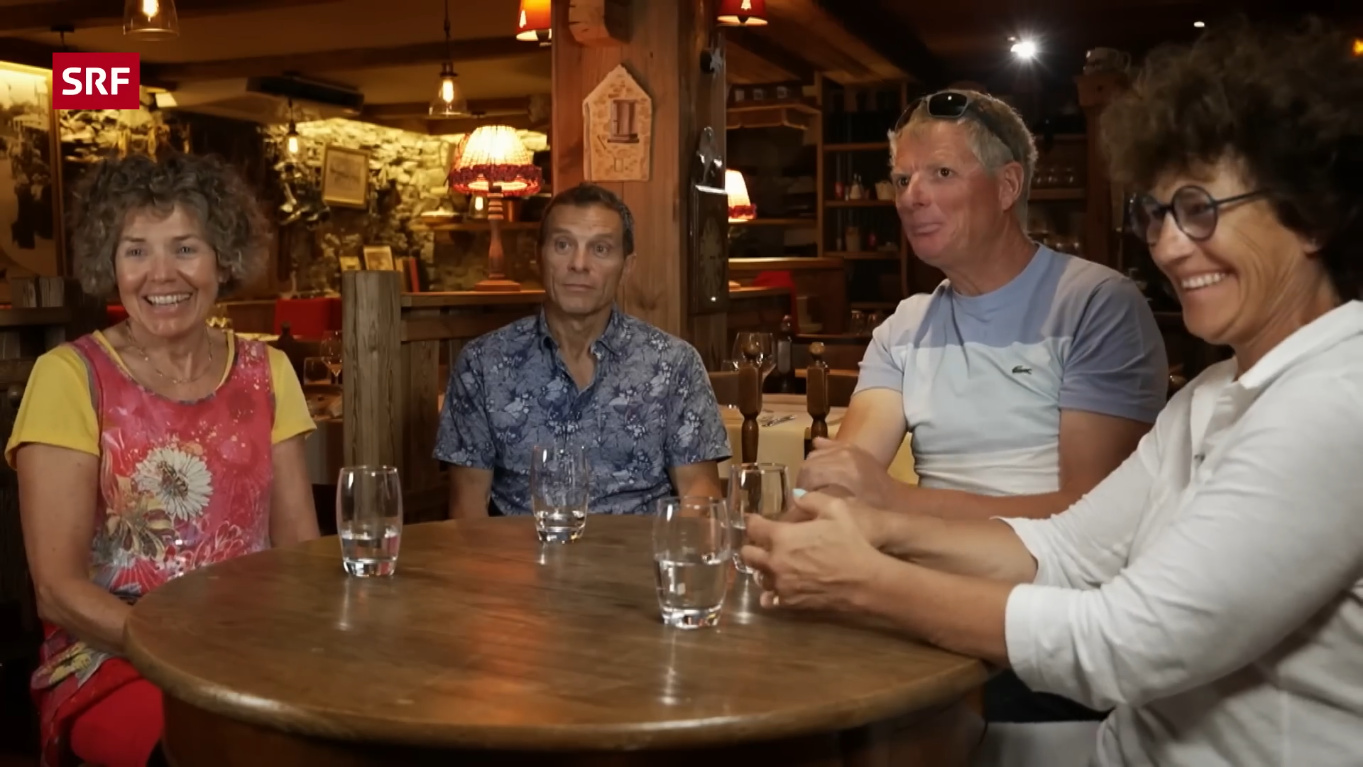
Francoise and Thierry Barcan, Philippe and Nathalie Barcan
The two couples Barcan and Reymond are close friends from Tignes, and have been hiking together in the mountains for years, without a mountain guide. They laugh: "We never take a mountain guide. We know the mountains quite well. We've been doing this since we were young. On the Haute Route, with our experience, topographical materials, and maps, we never felt the need for a guide."
Philippe and Thierry are certified ski and snow sports instructors. Philippe is also a member of the mountain rescue team. Philippe and Thierry share responsibility for the tour and rely only on maps and compasses on the Haute Route. They knew there was a window of opportunity before the foehn winds arrived, and they wanted to take advantage of it. According to the forecast, the weather would remain stable until 2 pm.
Steve House group
The photo is taken in Cabane de Vignettes at the night of the disaster, April 29, 2018.
The group is oblivious to the tragedy unfolding in the storm outside.
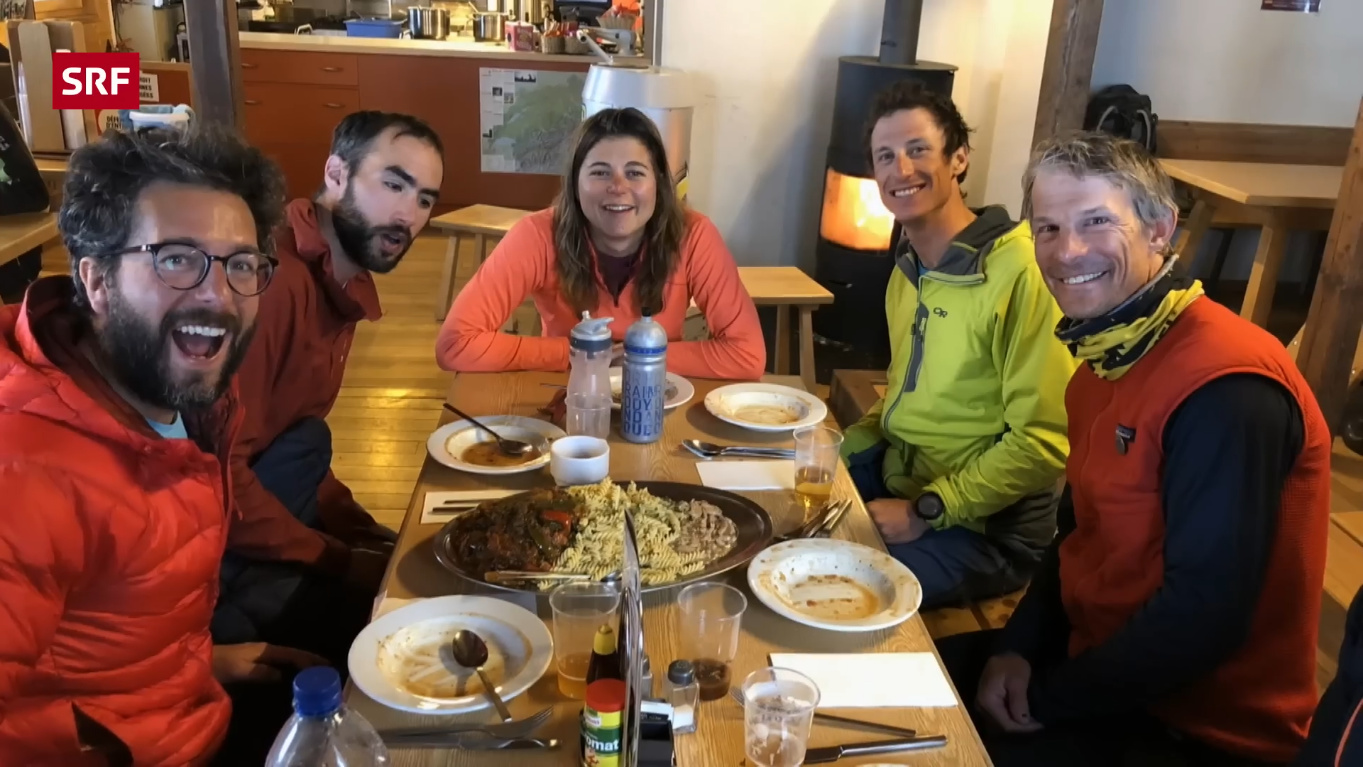
Steve House's two clients, Duverney's girlfriend, Simon Duverney and Steve House
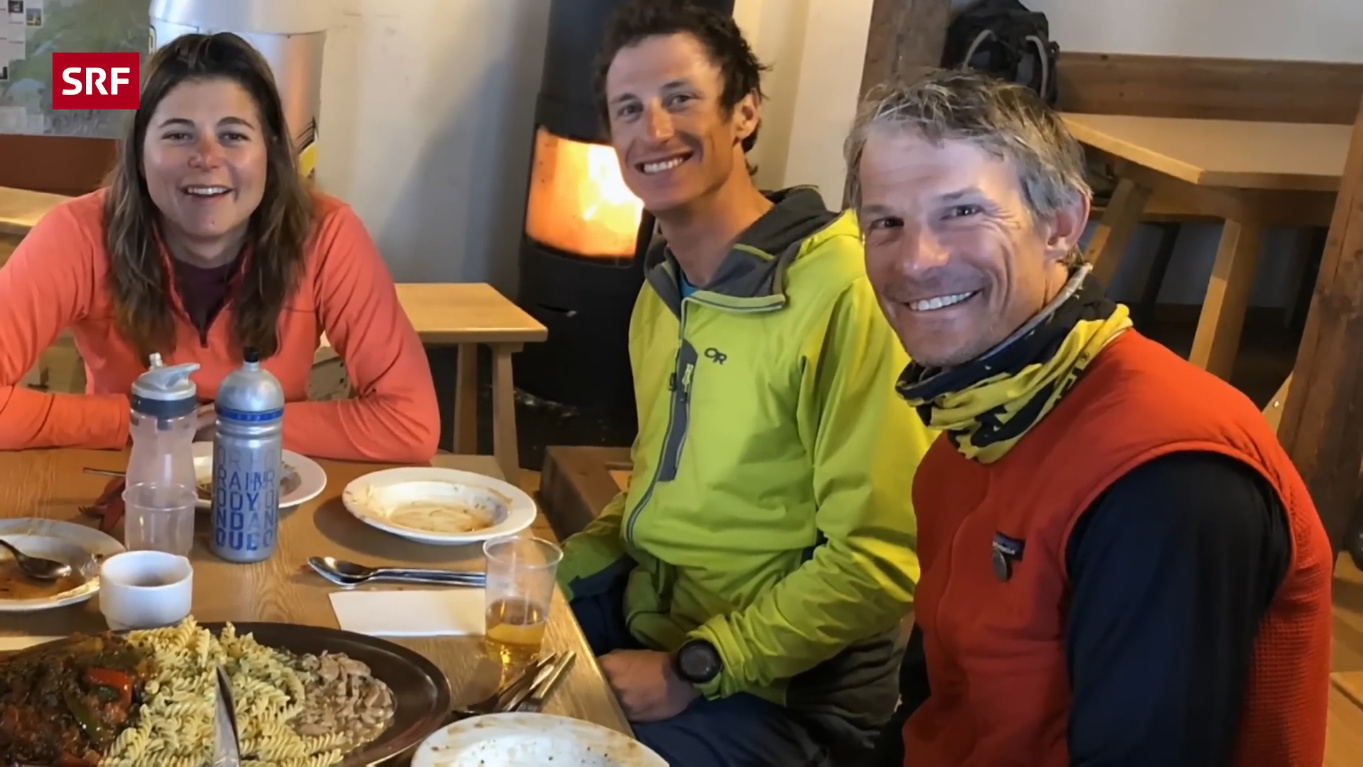
Duverney's girlfriend, Simon Duverney and Steve House
- 3 -
The first days were just like the catalogue had promised: Blue sky, white snow, descents into valleys and ascents to peaks as high as 2,459 meters. On Friday, Day Two, Tommaso read the weather report: The warm, dry wind that had afforded them clear and sunny skies so far would disappear by Sunday afternoon. The temperature would plummet, and a storm would settle in. But Sunday was a long way off.
On Saturday, Day Three, their journey took them 17 kilometers over a steep landscape to the next lodge, Cabane des Dix.
The Wi-Fi reception in Cabane de Dix is poor and the only source of weather information in the hut is an iPad. Everybody was checking the same forecast to see what was brewing. A French mountain guide said: "Not in this weather."
Steve House group
Steve House arrived with his guests around 12:00 pm. The first thing he did in the hut was check the weather for the next day and was alarmed. Steve House words are "The forecast wasn't just talking about a small storm, but about super-strong gusts of wind. I don't remember the details, but it wasn't like anything bad or unpleasant weather forecast. It looked like it would be unsurvivable. That was the forecast."
As a mountain guide, the Haute Route was never on his list. He usually looks for tours off the beaten track. But two of his regular guests wanted to make this dream come true. Already on the ascent in the morning, Steve House recognizes the cloud front from the south, this is the storm that he has been observing for days. They reached the Cabane des Dix at noon, had lunch and his guests lay down. Steve House skied up to the Pigne d'Arolla, the saddle from which you then ski down to the Cabane des Vignettes. He had never done that section before so he climbs 800 m of altitude from the Cabane des Dix to the saddle of the Pigne d'Arolla at 3,680 m and lays a GPS track for the first part of tomorrow's route. He saves the route with points and data on his GPS. At that point, it was clear that the forecast storm was indeed approaching. He needed a perfect GPS track to follow, because tomorrow could be really difficult. For the second part of tomorrow's route Steve House teamed up with Simon Duverney, a mountain guide friend who had descended from the Pigne d'Arolla to the Cabane des Vignettes two weeks earlier and he had this GPS track on his phone.
When asked if he would have been able to find the way to Cabane des Vignettes without a GPS track, Steve House answered that he wouldn't have attempted it without a good GPS track.
- 4 -
Most of the groups decide to stay in the Cabane des Dix, wait out the storm, or head straight to Arolla. Three groups set off towards Pigne d'Arolla this morning. Steve House and Simon Duverney are in the lead, followed by the Barcan and Reymond couples. Shortly after 6:30 am, Mario Castiglioni sets off too. His original plan was to reach Rifugio Nacamuli but in the morning he canceled the booking. It was obvious that they won't get this far in this weather.
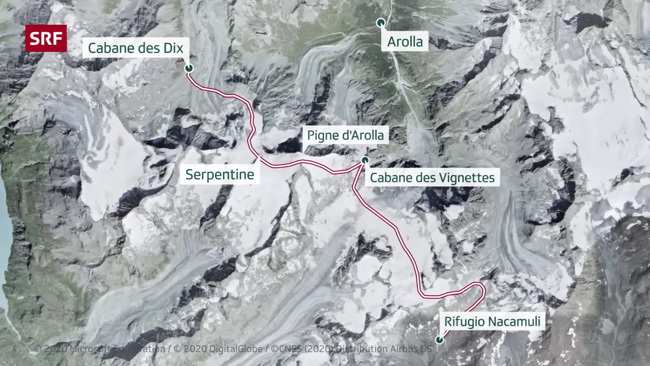
Original route to Rifugio Nacamuli is canceled
Mario was left with two options: the Cabane des Vignettes or turning back to Arolla. He did not make arrangements for either. He did not discuss his plans for the day with group.
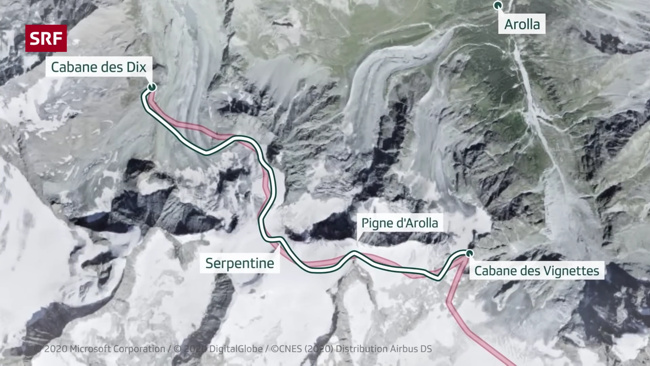
Route option 2 - Cabane des Vignettes
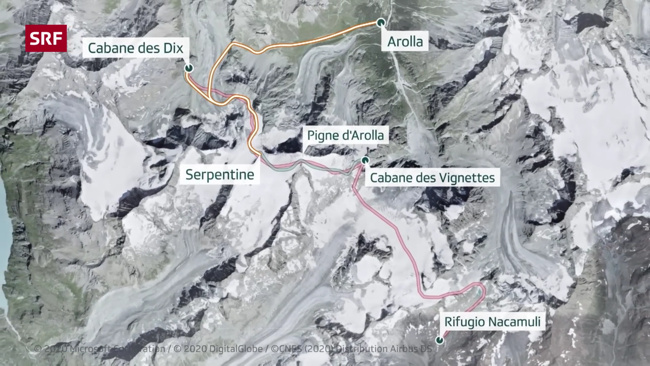
Route option 3 - turning back from the "Serpentine" and going to Arolla
Mario's group included faster and slower skiers. The skill level varied between those who were more active and those who were less prepared. Gabriella was the weakest member of the group. On top of that she had a problem with her foot and took off her ski boot during longer breaks.
- 5 -
The "Serpentine" - Stairway to Hell
Based on the GPS data from the groups, it is possible to reconstruct exactly who was traveling where and at what time that day. At around 9 am, all three groups arrived more or less together below the Serpentine, where a safe turnback would still have been possible. Steve House: "You could see that the storm was approaching. The clouds were pushing in, it was getting windier, there was moisture in the air. It was no longer dry and clear. There was no longer any doubt about what was really happening."
Luciano Cattori: "When we arrived below the Serpentine, there were other groups that were already up there. There were tracks, we followed them."
This was the moment when Mario decides against descending to Arolla and instead heads for the Cabane des Vignettes, against the approaching storm. Once on top of the plataeou it is more dangerous to turn back than to continue to Cabane de Vignettes. The "Serpentine" is the bottleneck on the way to the Pigne d'Arolla: 40 degrees steep and 300 m vertical drop towards Arolla. On the day of the accident, it is also icy and correspondingly challenging. Mario must have been aware at the time that turning back under these conditions would be practically impossible. And now there's only one way: across the vast expanse of the Col du Brenay at over 3,000 m, in a storm.
A big change in a very short time - from blue skies and a bit of wind to a full-blown storm. TIt started to get fierce on the plateau. Philippe Raymond: "It was a real wall of foehn wind." Nathalie Reymond: "The fog came on very quickly. Visibility 10 m, it was crazy. The fog enclosed us." Francoise Barcan: "I remember looking up and thinking, damn, I can't see anything anymore." Philippe Raymond: "As we continued, all traces were blown away by the wind."
The storm hit earlier than expected
Images from the webcam in Arolla towards Pigne d'Arolla: The foehn storm from the south sets in at 10 am instead of 2 pm as predicted.
The radar image from Meteo Switzerland also shows how a first wave builds up at 10 am and then around 2 pm the big storm hit with full force.
When Mario's group arrived on the plateau the gusts of wind reach 80 km/h.
- 6 -
After the tragedy, the Valais public prosecutor's office opened an investigation, which confirmed, that all participants were well equipped and that the mountain guide Mario had a rope, satellite phone, a GPS watch, and a GPS phone with him. Tommaso Piccioli also carried a GPS.
| Mario Castiglioni | The "French" | Steve House | |
| Members | 10 | 4 | 5 |
| Mountain guides | 1 + 1* | - | 2 |
| GPS | 3 | - | 2 |
| Satelite phone | 1 | - | - |
For some reason I am not yet aware both Mario's GPS and watch do not work. Tommaso offers his GPS maps, problem is that they are summer routes, but they are way more better than nothing. For some reason Mario refuses and for many hours tries to find his way in the fog and hurican-force wind, dragging the group with him. Based on Tommaso's recorded GPS data, it is possible to reconstruct what happened in the next 24 hours. You can see how the group wanders around for the next 6 hours at over 3,000 m on the Col du Brenay. Instead of ascending directly to the Pigne d'Arolla, the ten alpinists head in the wrong direction from the start. In contrast to Steve House who follows his GPS data and reaches the saddle of the Pigne d'Arolla directly at 10:37 am.
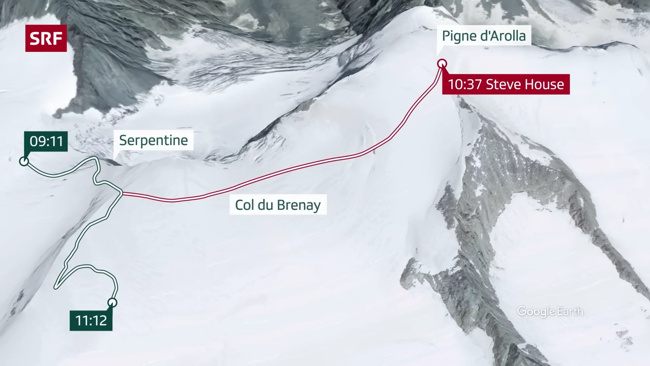
Steve House arrives at the saddle Pigne d'Arolla at 10:37
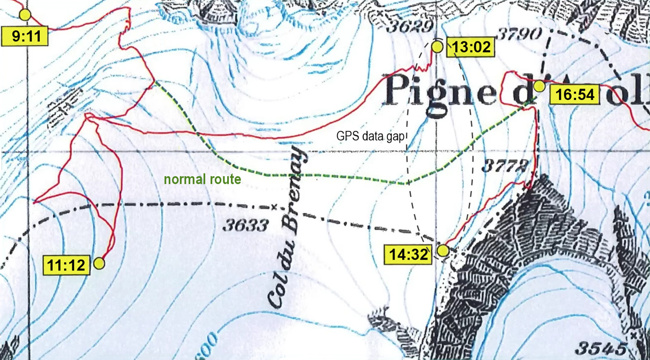
Tommaso GPS data (missing data between 13:02 and 14:32)
Tommaso is ofering to Mario to look at the map (summer route) on his GPS, but Mario is adamant to manage on his own. While groping in the fog they cross paths with the Barcan and Reymond couples, who are trying to orient themselves with a map and compass. They do not know Mario, but he is a mountain guide after all, and Kalina convinces them to follow Mario. A conversation that almost proved fatal for the French.
Philippe Reymond: "We had a compass and a map. I had completely different idea which way to go. I was completely surprised and didn't want to follow him at first. And then, it was because of Mario's wife, the last one in the group, Kalina. She made the difference. We were undecided. Then she told us: "The mountain guide knows the route by heart. He just needs to get his bearings, then he'll find the direction. You don't have to worry." Nathalie and I looked at each other and decided it was better to get lost with fourteen than with four." Tommaso looking at his GPS, the only one working in the group, and showting to Mario in the blizzard: "That's not the way!" Frenchmen Thierry and Philippe are still not convinced. They have doubts. Philippe Raymond: "I went up to him and said, "That can't possibly be true." I think Mario had similar feelings to us. "Those French guys over there..." Nathalie Reymond: "You told us he was annoyed. "Those four French guys following us are not my clients." This led to tensions. Suddenly, Mario is the only mountain guide responsible for 14 people in the whiteout.
- 7 -
Steve House group
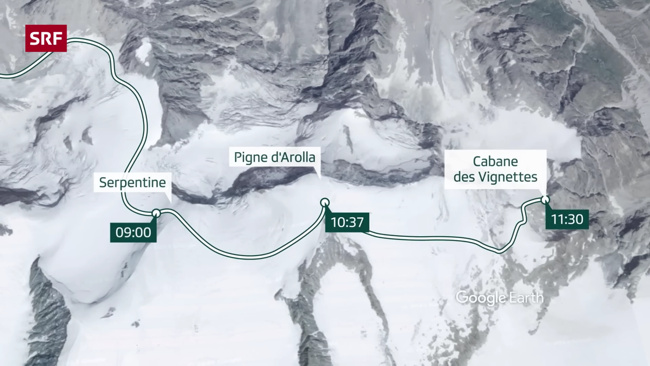
Steve House group arrives at Cabane des Vignettes at 11:30 am
Round of applause for the guides
Steve House trying to bring the skis to the ski room at Cabane des Vignettes around 12 pm
On Steve House footage, at the begining of the firts one and the end of the second, you can see a long suspended water hose. This is a landmark to the hut, but it is more than 200 m long and suspended in the air. Mario's group tries to follow it but they reach a chasm that they can't see how to get around. By the time they reach the hose the visibility was very poor.
Mario's group
Mario decides to untie his skis and continue on crampons, so that he has better control over the large group and the participants have better grip in the storm. Mario had a red rope in his backpack. He tied the rope to himself and threw it to the rest. Kalina walked last, and everyone always had the rope close by. Julia: "We weren't roped together, but he tied it around himself and pulled a long piece of rope behind him. That really helped because it was a landmark in this whiteout. Snow below, snow above, white clouds, storm. You could follow the rope, which was very helpful." Mario keeps trying to activate his cell phone, but it doesn't work. He starts asking: "What does your GPS say?" Tommaso: "I was holding the GPS. Mario came and went. I don't know, he was looking for something." Mario is losing control over the group as a mountain guide. Since setting off this morning, they've been on the trail for over 6 hours. Julya: "It was always this white storm, lots of wind, lots of snow. You couldn't see very clearly – perhaps fortunately – what was below you. But you didn't know where you were going either. At one point, I also got angry and wanted more explanations. I then said to Kalina: "What are we doing? Where are we?" I was really scared. But then I got an answer that calmed me down a lot – Kalina said: "This isn't the moment to discuss or argue; we'll do that this evening at the hut during the debriefing." I felt supported and said: "Yes, you're right, we don't need to freak out here now, but tonight in the hut..." And we moved on."
Around 1 pm, they reach the Pigne d'Arolla area. They're on the right track. And then this GPS hole. It's unclear what happened here. Around 2:30 pm, they suddenly appear under this rock formation.
Steve House: "When I look at the Col du Brenay as a mountain guide, it's very confusing. The terrain slopes down on all sides; it's very flat. In this small area, it's very easy to get lost in a whiteout. You're walking in circles and completely losing your bearings."
The cell reception on the Col du Brenay is also very poor. Moreover, Mario apparently doesn't have any spare batteries for his cell phone, nor a working GPS. Nor a device that could have sent an emergency signal via satellite.
- 8 -
After more than 6 hours of wandering, they reach the saddle of the Pigne d'Arolla at 4:54 pm. Under good weather it takes 45 minutes to cross the glacier.
Then, the first glimmer of hope for the group. Luciano: "When we reached the end of the Col du Brenay, you could see a section of the descent. We assumed we'd make it." Tommaso recognized the hut on his GPS; they're on the right track. They continue without a break, without drinking or eating. Two groups form: the stronger ones in front, Kalina with the weaker ones behind. In addition, one participant lost her climbing harness, and Kalina had to carry one of her skis.
Around 5:50 pm, another glimmer of hope appeared - they reached the cairns, the passage to the Cabane des Vignettes, just 550 m from the rescue hut. It's the bottleneck on the way to the Cabane des Vignettes. The cairns mark the passage of the original route to the hut, which crosses the slope over the glacier and then leads through a rocky col to the Cabane des Vignettes. When Mario's group arrives here, they're already completely exhausted. They just want to go there.
The link between the hut and the scene of the drama is this water hose stretched in the air, which runs over the steep glacier below the original route and the cairns. They were actually on the right path, but the end of the water hose was hanging off and led into the steep section. In the storm, they couldn't see the further route of the water hose to the hut.
Mario lost his glasses and is snowblind. The storm is now raging at over 120 km/h.
Mario group meet the French at the cairns. They suggested going down the glacier. The French remember that there is a second path besides the original route. The descent is also visible on Tommaso's GPS. They all go down. Françoise Barca altimeter shows they have to go up, that we were too low compared to the hut. Mario shouted: "No, you're too low, you have to climb back up." Tommaso only had the summer route installed on his GPS, which differs only slightly from the winter route. However, in a storm, this can be misleading. Tommaso: "I had the map on the GPS that led down, but there was nothing down there. No red line indicating a path. The path was marked above, but we couldn't find it. It's very dangerous." Luciano: "Then Mario told us to climb back up... At the end, Mario gave me the red rope and said, "You go up. I'll stay here and help the others climb. It took us almost an hour to climb 100 meters. We were all tired."
- 9 -
It's now 7:30 pm. The storm reaches its peak with gusts well over 150 km/h. The temperature in the storm is well below -20°C. Everyone is completely exhausted after more than 12 hours without a proper break or food.
Luciano: "When I arrived there, the wind was incredibly strong, even worse than before. I was on my knees to avoid being knocked over. At some point, Mario came and said, "That's enough. We're waiting for Gabriella now so we're all together." Then he said, "We'll stay here and camp." It was quite clear, Mario had already said so, that we would stay there. I said to Mario, "If we stay here, we're all dead." Mario said, "The others can't go on." "We have to try to dig in, find some shelter... and save ourselves." We tried to group ourselves close together, to ward off the wind, to keep warm. We were lined up – sitting, half-lying on top of each other." Julya: "In front of me, partly on my legs, was Gabriella. There was a large rock, and we thought it would protect us from the wind."
Luciano: "Andrea and I tried to dig a hole with the axe, but it was very hard. I'm not physically built for this cold. I was shaking after just 10 minutes. Mario's whole face was shaking too. He was completely exhausted, devastated... I went to him and said: "Mario, we tried to dig a hole, but it's not working." "Some people are in very bad shape." "It's important to dig a hole, otherwise we won't survive." I can't see anything. And his answer was: "I can't do anything. I can't see anything." He was blind. Mario was completely exhausted. I've never seen Mario like this. Mario wanted to camp there, but it was too dangerous. I told him, "We can't bivouac here." It was very windy.
The French mustered enough strength to climb 30 meters up and seek shelter behind a rock. Thierry Barcan: "We dug out blocks of ice and hard snow from under a rock and built a small wall on the side to block the wind. We tried to set up a windbreak with your skis and backpacks. Everything flew away—the skis, Nathalie's backpack, everything..." Nathalie Raymond: "I asked you if we were going to die. You said, "No, we won't." And I trusted you. I'd always kept that in mind."
While the French found some shelter, Mario's group was completely exposed to the storm that raged all night. They treid to talk to each other, get some food, and water... Tommaso was rocking back and forth throughout the night. But everybody was getting quiter and quiter... Julya; "Is that it? Are we dead?"
The Barcan and Reymond couples had registered at the Cabane des Vignettes and were thinking at some poit that somone might start looking for them. Mario never registered his group at the hut. The warden explained that so many didn't didn't bother to cancel that he can't call the rescue services every time people don't show up. At some point, in the middle of the night, Mario finally pulls himself together with his last bit of strength. He went over to Julya and sat down on her right side. Julya: "Mario, what about the satellite phone? Let's finally use this satellite phone." And then they took Mario's satellite phone out of his backpack and it lit up. Julya says it lit up red and green. He had it with him. It had juice. But it didn't work. And after awhile he got up and was gone.
Luciano: "I remember that I started to dream. I dreamed of beautiful things, I wasn't even cold anymore. I was fine. I just wanted to sleep, and that was it. I dreamed of surreal landscapes with flowers and spinning garlands. I remember everything very well. And then nothing. Not until the hospital in the afternoon. What happened next is known only to those who rescued us." Julia tries to understand and flies back to the accident site in the summer with rescue specialist Pascal Gaspoz. He explains that the French were a bit further up near a big rock, very close, 30 to 40 m away. Were the wind and weather conditions really better there? The two places are very different. The place up above is protected from the wind. Mario's group was in a small pass, where the wind picks up speed. The perceived temperature is 15 to 20°C lower where you spent teh night. Your chances of survival were completely different. You can't compare them. This is probably the reason why the French survived the night. Nathalie is the only one who loses consciousness in the morning due to severe hypothermia, but she could still be rescued.
- 10 -
It is 6:30 am on April 30, 2018. The storm has abated somewhat, and the clouds have cleared.
Steve House is getting ready in the Cabane des Vignettes for the last leg of his tour to Zermatt. Simon Duverney in front, Steve House at the back. We're skiing across the plain when Simon found Mario. As Simon climbs up to him, he realizes Mario is dead. Mario managed to find the way to the hut, but then collapsed from exhaustion and hypothermia and died. Ultimatelly he saved 7 people. No one saw or heard any of the survivors. It was only after Steve House returned to the hut and raised teh alarma thatt the helicopters found the group.
Had Mario not struggled to his feet and walked on, Steve House would have continued his trek, and no one at Cabane de Vignettes would be the wiser that people are dying 550 m away. The bodies would have been found by the next skiers coming to hut since the group spent the night at the bottleneck where everyone has to pass.
Seven helicopters are deployed: Air Glaciers, Rega, and Air Zermatt working together under time pressure. Fourteen people are taken to the Cabane des Vignettes, where they are cared for by the emergency doctors present and flown to the Valais hospitals, as well as to Lausanne and Bern. Six of them die in the hospital. Luciano is also no longer conscious, when he is admitted to the Inselspital in Bern. He was in the intensive care unit and in poor condition - 26°C body temperature, 5 heartbeats, thickened blood. They had to change all his blood. Luciano survived, as did Tommaso and Julia, who were both able to leave the hospital with mild frostbite. But the trauma and questions remain.
What happened that day? Was it bad luck? Human error? Or carelessness?
If we pass the first that comes to mind: The whole thing shouldn't have happened. Humans aren't stronger than nature. It's stupid to put yourself in such a situation. Mario had too much confidence in himself etc. What can we learn from this incident?
Steve House: "I've been in such situations too many times and know how quickly things can go wrong and you end up on the wrong side. It's often a very narrow ridge. And if you're on the wrong side, it's a matter of life and death.
Mario's body
Photos from the Haute Route 2018











